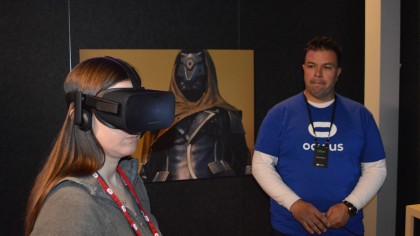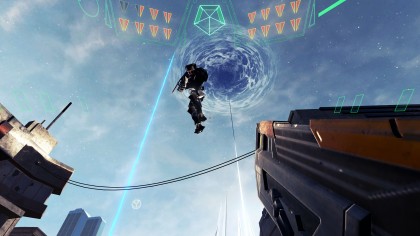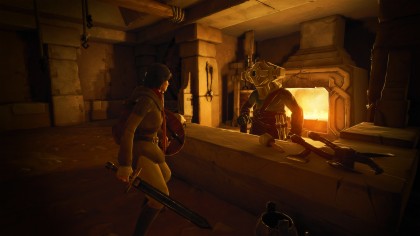These Oculus Rift launch games would immediately justify my huge overdraft
Games are Oculus Rift's secret weapon
Damaged Core (Spring, price not announced) was next on my list, and was my favorite title of the day. This was the first Rift game I've ever played standing, and I loved it.
In the game, I was a good robot created to taken down my evil brethren, though I had the added ability of swapping bodies with them if my health depleted to a too dangerous level.

When I targeted and swapped bodies with another robot, I was immediately put in their shoes and picked up right where they were standing. I could swap with an automaton who was above, many feet away or right next to me. Each time I swapped, I was able to get my bearings almost instantly and start killing robots until I was discovered, turned upon and had to start the whole process over again.
It was just the right level of intensity without being overwhelming. Producer Doug Seebach of High Voltage said it took the team three months to find the reticle (the aiming guide) for Damaged Core so that players could swap bodies without losing their bearings in a VR world. The dedication paid off: I seamlessly transitioned from body to body and barely missed a beat. I killed a lot of robots, and it felt great.

One question I had, however, was about the Rift's tether when you're playing standing up. After trying on the AMD-powered Sulon Q, which lays claim to the first tether-less VR headset, I asked Seebach if the Damaged Core developers felt it encumbered the game's development or the player experience.
"We designed it for PC," Seebach said of the game. "With the tether, we take into account the zero position. You always go back to that zero point, so you don't run into the cord."
The fact that the Rift is attached to a fixed point didn't seem to bother him in the slightest. And, honestly, I didn't notice it in any measurable manner while I was blasting killer bots.
Sign up for breaking news, reviews, opinion, top tech deals, and more.

I sat back down for Chronos (March 28, $49.99), a Comfortable RPG that took its time getting to the action, but was beautifully rendered. I could almost feel the wetness of game's rain puddles as they splashed around me.
Oculus Rift is ready - are you?
I left the Oculus Rift GDC event thrilled for the headset. Neither it nor the games were absolutely perfect, but it was more than enough to convince me that I want one, and there will be plenty of content for me to choose from once I get it.
The one sticking point, of course, is the price. And it's not even for the Rift itself, but rather the PC required to run it. If not for the $1,500 (about £1,061, AU$2,011) compatible PC price tag, I'd buy a Rift at launch just to try more of the games and other content it will run.
The developers at this event, which was organized by Oculus, had nothing but good things to say about what it's like to work with the headset maker. They called it supportive and a true partner, which isn't often the case in the cutthroat world of game development.
While VR presents particular challenges to developers - one said it's like relearning to solve the problems they already figured out for non-VR games - almost all said they believe VR is the future, and Oculus is doing everything it can to make the journey a smooth one.
Oculus has invested in its developers because it wants them to succeed, and it knows it will benefit as a result. It's an investment I think is poised to pay off many times over, and I can't wait to play these games again, plus the hundreds more that will surely follow.

Michelle was previously a news editor at TechRadar, leading consumer tech news and reviews. Michelle is now a Content Strategist at Facebook. A versatile, highly effective content writer and skilled editor with a keen eye for detail, Michelle is a collaborative problem solver and covered everything from smartwatches and microprocessors to VR and self-driving cars.